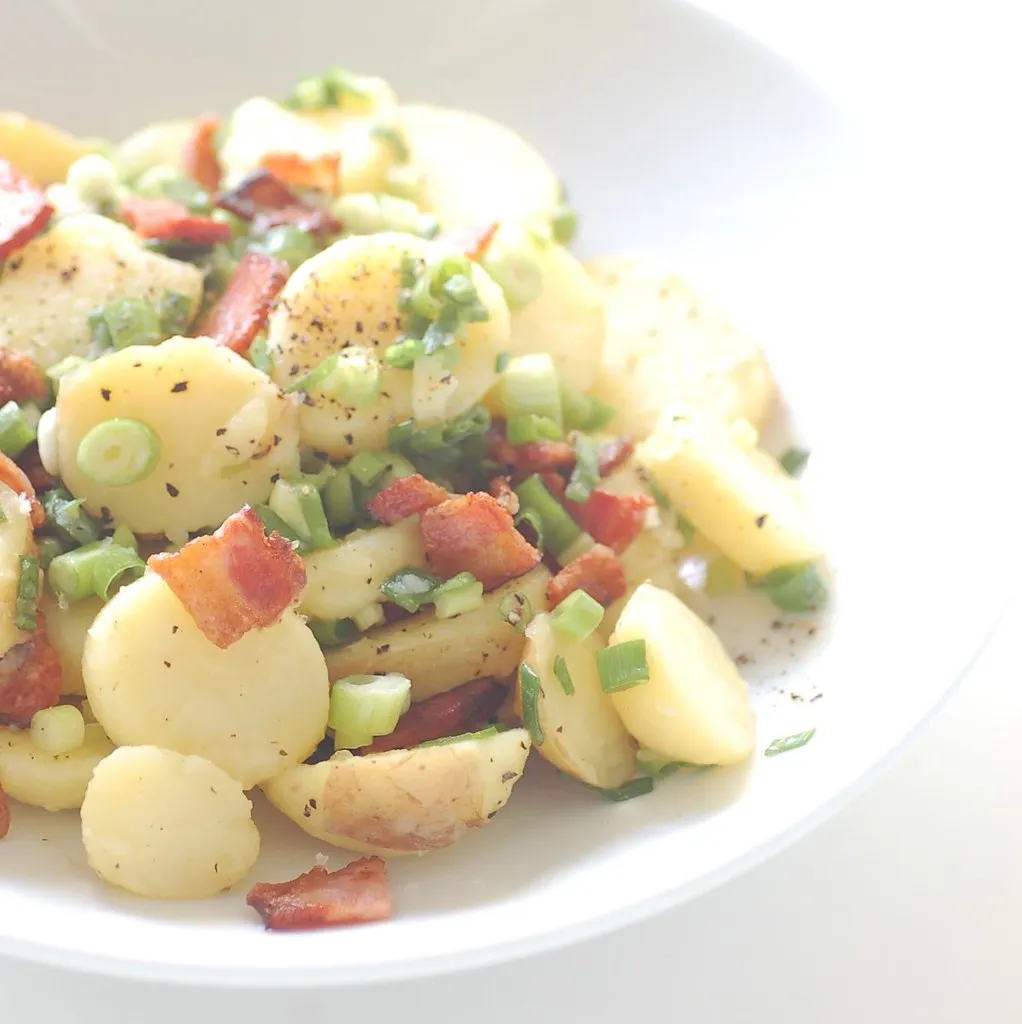The Best Fluffy Pancakes recipe you will fall in love with. Full of tips and tricks to help you make the best pancakes.
Warm potato salad is one of those timeless side dishes that can elevate any meal, whether it’s a summer barbecue or a cozy family dinner. Unlike the classic cold potato salad, this warm version offers a comforting blend of tender potatoes, creamy dressing, and fresh herbs that make every bite irresistible. The beauty of warm potato salad lies not only in its flavors but also in its versatility — you can easily customize it with ingredients like bacon, onions, or even fresh vegetables to suit your tastes. In this recipe, we’ll guide you through making the perfect warm potato salad that’s easy, flavorful, and sure to become a favorite at your next gathering. Let’s dive in!
The Secret to Perfect Warm Potato Salad
When it comes to creating the perfect warm potato salad, there are a few key elements that make all the difference. From selecting the right potatoes to mastering the boiling process, these steps are essential in achieving that flawless, creamy, and flavorful result that will leave everyone asking for the recipe. Let’s break down the secrets to getting your warm potato salad just right.

Choosing the Right Potatoes
Not all potatoes are created equal when it comes to potato salad. The type of potato you choose will impact both the texture and flavor of your salad. For a creamy, perfectly textured salad, Yukon Gold potatoes are often considered the best option. Their waxy nature allows them to hold their shape well when boiled, creating a smooth and creamy texture without becoming mushy. If you prefer a firmer, chunkier texture, you can also opt for baby potatoes or red potatoes, which are smaller and have a slightly thicker skin that adds to the salad’s bite.
Why Temperature Matters
The magic of warm potato salad is in the temperature. Serving the salad warm helps to enhance the flavors of the dressing and allows the potatoes to absorb the creamy, tangy ingredients more effectively. When potatoes are hot, they open up, making them more receptive to the seasonings and dressings you toss them in. A cold potato salad, on the other hand, can sometimes taste flat or bland since the potatoes don’t absorb the flavors as well. By serving it warm, you ensure that every bite is rich and flavorful. Make sure to serve it soon after mixing, or gently reheat it if necessary, to keep that ideal temperature.
How to Boil Potatoes for the Best Texture
Boiling potatoes may sound simple, but there’s an art to getting the right texture for potato salad. Start by placing the potatoes in a large pot and covering them with cold water — this helps them cook evenly. Adding salt to the water is crucial as it helps season the potatoes from the inside out. Bring the water to a boil, then reduce the heat to a simmer. The key is to cook the potatoes until they’re just tender — you can check by poking them with a fork. Be careful not to overcook them, as they’ll become mushy and break apart when mixed with the dressing. Ideally, you want the potatoes to be soft enough to easily bite into, but firm enough to hold their shape in the salad.
Key Ingredients for a Flavorful Warm Potato Salad
The beauty of a warm potato salad lies not just in the potatoes themselves, but in the blend of ingredients that make it rich, creamy, and bursting with flavor. While the recipe may vary based on personal preferences, there are a few essential ingredients that truly bring this dish to life. Let’s explore the key ingredients that will transform your warm potato salad into something truly special.
The Role of Mayonnaise and Mustard
A classic warm potato salad dressing usually includes mayonnaise, which acts as the creamy base. Mayonnaise provides that silky smooth texture and mild flavor that perfectly complements the tender potatoes. But what really elevates the salad is the addition of mustard. Whether you use classic yellow mustard, Dijon, or whole-grain mustard, it adds a tangy bite that balances out the richness of the mayo. The mustard’s acidity also brightens up the dish and gives it that extra layer of depth, making every bite more interesting and satisfying. The combination of mayo and mustard creates a perfect dressing that coats the potatoes beautifully and enhances their natural flavor.
Fresh Herbs for a Burst of Flavor
The fresh herbs you choose will infuse the salad with an aromatic and flavorful touch. Parsley, dill, and chives are some of the best herbs to pair with warm potato salad, each adding a unique flavor profile that makes the dish even more irresistible. Parsley offers a fresh, slightly peppery taste that lightens up the creamy texture, while dill brings a tangy, slightly earthy flavor that complements the mustard and mayo. Chives provide a mild onion-like taste that adds a delicate sharpness, perfect for balancing the richness of the other ingredients. Using fresh herbs instead of dried ones will give the salad a vibrant, bright flavor, which is essential in a warm potato salad that you want to feel fresh and not too heavy.
Adding a Touch of Bacon
While not always a staple, bacon is a fantastic optional ingredient that can add an incredible depth of flavor to your warm potato salad. Crispy, crumbled bacon introduces a salty, smoky element that contrasts beautifully with the creamy dressing and tender potatoes. Bacon also adds a satisfying crunch that complements the smooth texture of the potatoes. If you’re looking to elevate your salad further, consider adding bacon for that savory, umami punch that takes the dish from good to extraordinary. For a lighter twist, turkey bacon can also be used as a healthier alternative.
Vinegar for a Zesty Kick
Another key ingredient that can make a big difference in your warm potato salad is vinegar. Adding a touch of vinegar helps to cut through the richness of the mayonnaise and mustard dressing. Apple cider vinegar is a popular choice because it brings a mild tanginess with just a hint of sweetness, making it a great match for potatoes. You can also experiment with white wine vinegar or red wine vinegar for a more pronounced acidity. The vinegar balances the salad’s flavors and helps bring out the natural sweetness of the potatoes, giving it that perfect bite.
How to Make the Perfect Warm Potato Salad
Making the perfect warm potato salad involves more than just combining a few ingredients. It’s about the right preparation, timing, and techniques to ensure each component is perfectly cooked and the flavors are balanced. This section will guide you step-by-step through the process, ensuring your warm potato salad turns out creamy, flavorful, and irresistible every time.
Step 1: Boiling the Potatoes
The first step in making a perfect warm potato salad is boiling the potatoes to the right consistency. Start by choosing the right type of potato, like Yukon Gold or baby potatoes, as mentioned earlier. These varieties hold their shape well during boiling and have a creamy texture.
- Preparation: Begin by scrubbing the potatoes to remove any dirt. If you’re using baby potatoes, you can leave the skins on for added texture and flavor. For larger potatoes, peel them if you prefer.
- Boiling: Place the potatoes in a large pot and cover them with cold water. Adding cold water ensures that the potatoes cook evenly. Add a generous amount of salt to the water to season the potatoes as they cook.
For this step, I recommend using a high-quality, nonstick saucepan like the Ninja NeverStick Hard-Anodized Saucepan for even heat distribution and easy cleanup. - Cooking Time: Bring the water to a boil over medium-high heat, then lower the temperature to a simmer. Depending on the size of your potatoes, they should cook for 10-15 minutes. To check for doneness, poke the potatoes with a fork — they should be tender but not mushy. Be careful not to overcook them, as this can cause the potatoes to break apart when mixed with the dressing.
Step 2: Preparing the Dressing
While your potatoes are boiling, it’s time to prepare the dressing that will bring your warm potato salad together. The creamy, tangy dressing is a key element in achieving the right flavor balance.
- Basic Dressing Ingredients: In a bowl, combine mayonnaise, Dijon mustard, and apple cider vinegar (or your preferred vinegar). The mayo gives the dressing its creamy base, while the mustard adds a tangy sharpness that cuts through the richness. The vinegar adds a zesty kick and helps balance the overall flavor.
- Seasoning: Add a pinch of salt and pepper to taste, and for extra flavor, you can include a little garlic powder or onion powder. If you like a bit of sweetness, you can also add a small amount of honey or sugar to round out the dressing.
- Consistency: Stir everything together until it’s smooth and well combined. The dressing should be thick enough to coat the potatoes but not too heavy. If it feels too thick, you can thin it slightly with a tablespoon of water or extra vinegar.
Step 3: Combining the Ingredients
Now comes the fun part—bringing everything together to create your warm potato salad.
- Tossing the Potatoes: Once the potatoes are cooked and drained, allow them to cool slightly, just enough so they can be handled comfortably. While the potatoes are still warm (but not hot), transfer them into a large mixing bowl. The warmth of the potatoes will help them absorb the dressing more effectively, ensuring every bite is flavorful.
- Adding the Dressing: Pour the prepared dressing over the warm potatoes. Gently toss the potatoes with a spatula or spoon, making sure the dressing coats every potato chunk. Be careful not to break the potatoes apart while mixing. If you like, you can use a rubber spatula to lift and fold the potatoes rather than stirring too vigorously.
- Fresh Herbs and Optional Add-ins: Once the potatoes and dressing are mixed, add the fresh herbs like parsley, dill, and chives. These herbs should be chopped and added last, so they retain their vibrant color and fresh flavor. If you’re including optional ingredients like bacon, hard-boiled eggs, or onions, fold them into the salad at this stage to distribute evenly throughout.
Step 4: Letting the Salad Rest
Once everything is mixed, let the salad rest for about 10-15 minutes. This allows the flavors to meld and gives the potatoes a little time to absorb more of the dressing. The salad can be served warm immediately, but if you prefer, you can refrigerate it for an hour for a slightly cooler, more developed flavor. However, serving it warm will give you the full experience of that creamy, comforting texture.
Customizing Your Warm Potato Salad
One of the best things about warm potato salad is its versatility. You can easily adjust the recipe to suit your personal preferences, dietary restrictions, or even the theme of your meal. Whether you prefer a more robust, smoky flavor or a lighter, fresher twist, customizing your warm potato salad is simple. Let’s dive into some delicious variations and ingredient additions that will take your salad to the next level.
Add-Ins for Extra Flavor and Texture
If you love to experiment with different textures and flavors, there are countless add-ins that can elevate your warm potato salad. Here are some of the most popular ingredients to consider:
- Bacon: The smoky, crispy goodness of bacon adds both flavor and crunch. Crumbled crispy bacon is a great way to add a savory, salty element to your salad. For a twist, you can also use turkey bacon for a leaner option without sacrificing flavor.
- Hard-Boiled Eggs: For added richness and a creamy texture, chopped hard-boiled eggs are a classic addition to warm potato salad. They enhance the dish with protein and make it more filling, turning it into a heartier meal.
- Cheese: If you love cheese, consider adding some shredded cheddar, parmesan, or even feta. The salty, creamy cheese will melt slightly into the warm potatoes, adding a satisfying richness.
- Olives or Capers: For a touch of briny flavor, toss in some green olives or capers. These ingredients add a savory tang that contrasts wonderfully with the creamy dressing.
- Crispy Onions: Adding crispy fried onions or sautéed onions brings a subtle sweetness and a crispy texture that complements the soft potatoes perfectly. If you prefer a sharper bite, opt for red onions or shallots.
Vegetarian and Vegan Variations
If you’re looking to make your warm potato salad vegetarian or vegan, there are easy swaps to accommodate different dietary preferences without compromising on flavor.
- Vegan Mayonnaise: Instead of traditional mayonnaise, you can use vegan mayo made from plant-based ingredients. It will still give you that creamy texture, while keeping the dish entirely plant-based.
- Dairy-Free Alternatives: To make the salad dairy-free, choose dairy-free cheese options or skip the cheese altogether. You can also swap any butter used in cooking for a vegan butter substitute.
- Adding Plant-Based Proteins: If you’re looking for a plant-based protein boost, try adding tofu, chickpeas, or edamame. These ingredients can add a substantial texture and nutritional value without meat.
Seasonal and Regional Variations
Another great way to customize your warm potato salad is by incorporating seasonal ingredients or regional flavors. This allows you to get creative and make a unique version of the dish that fits your personal tastes or special occasions.
- Herb Variations: In the spring and summer, you might want to incorporate fresh herbs like basil, mint, or oregano for a lighter, fresher flavor. In colder months, herbs like rosemary or sage pair beautifully with the earthiness of roasted potatoes.
- Spicy Warm Potato Salad: If you love a little heat, consider adding jalapeños, chili flakes, or a spicy mustard to your dressing. The spice will contrast with the creamy base and give your salad a zesty kick.
- Roasted Vegetables: For a more robust salad, try adding roasted vegetables like bell peppers, zucchini, or carrots. Roasting the vegetables brings out their natural sweetness, which complements the potatoes and dressing.
- Barbecue-Inspired: If you’re serving your warm potato salad at a BBQ or cookout, why not give it a smoky flavor? Add a spoonful of barbecue sauce to the dressing or include grilled corn, grilled onions, or smoked paprika for an extra depth of flavor that fits perfectly with grilled meats.
Adding Fresh Fruits
For a refreshing twist on the traditional warm potato salad, you can add fresh fruits that balance out the richness of the potatoes and dressing. Fruits like apples, grapes, or cranberries add a surprising sweetness and texture that complements the savory elements.
- Apple: Sliced green apples (like Granny Smith) provide a tart crunch that contrasts nicely with the creamy potatoes.
- Grapes: Halved red or green grapes offer a juicy burst of sweetness, making the salad more refreshing.
- Cranberries: Dried cranberries (or fresh ones if in season) can add a chewy texture and a tangy sweetness that brightens up the dish.
With all these customization options, you can make a warm potato salad that perfectly fits your taste or occasion. Whether you’re aiming for a smoky, hearty dish or a light and fresh salad, there’s a variety of ingredients that can make your warm potato salad uniquely yours. Don’t be afraid to experiment with different flavors and textures to create a salad that’s truly one-of-a-kind.
Tips for Serving and Storing Your Warm Potato Salad
Warm potato salad is a delicious, comforting dish that’s perfect for a variety of occasions — from casual family meals to festive barbecues. However, how you serve and store the salad can make a big difference in the flavor and texture. Below, you’ll find essential tips on how to serve your warm potato salad to make it even more delightful, as well as the best ways to store it to maintain its freshness and taste.

Serving Your Warm Potato Salad
To ensure that your warm potato salad is presented beautifully and enjoyed to its fullest, here are some useful serving tips:
- Serve Warm (Not Hot): The best way to serve your potato salad is warm, but not piping hot. When it’s too hot, the dressing can become too runny, and the potatoes may lose their structure. Allow the salad to cool down slightly after mixing it, so it’s at a comfortable temperature for eating. This ensures the flavors are well balanced, and the dressing clings to the potatoes just right.
- Garnish for Visual Appeal: Garnishes can take your warm potato salad from good to great. Consider topping your salad with fresh herbs like parsley, chives, or dill to add a pop of color and freshness. You can also sprinkle crispy bacon bits or fried onions on top for extra texture and flavor. A light drizzle of extra dressing or a sprinkle of paprika adds an appealing visual and flavor contrast as well.
- Pair with the Right Dish: Warm potato salad pairs wonderfully with a variety of main dishes. It’s an excellent side for grilled meats, like steaks, ribs, or chicken, making it ideal for cookouts and barbecues. For lighter meals, serve it alongside a green salad or with a simple grilled fish. Its creamy texture balances out the richness of meats and adds a hearty, comforting element to any meal.
- Keep It in a Serving Dish with a Lid: If you’re serving warm potato salad at a gathering or picnic, it’s helpful to keep it in a large serving dish with a lid to retain warmth. A covered dish will also help prevent the salad from drying out if it sits for too long.
Storing Leftover Warm Potato Salad
Storing warm potato salad properly is essential for maintaining its flavor and texture for future meals. Here’s how to store and reheat your salad without compromising its deliciousness:
- Cool the Salad First: Before storing your potato salad, make sure it has cooled down to room temperature. Placing hot potato salad directly in the fridge can raise the temperature inside your fridge and potentially affect the quality of other foods. Allow the salad to cool for about 30 minutes to an hour after serving.
- Store in an Airtight Container: Once cooled, transfer your potato salad into an airtight container to prevent air exposure, which can dry out the potatoes and cause them to become mushy. Using a glass container is often a good choice, as it helps preserve the texture and flavor.
- Refrigeration: Warm potato salad can be stored in the fridge for up to 3-4 days. The potatoes will continue to absorb the dressing, making the salad even more flavorful the next day. However, be aware that the potatoes may become slightly softer with time, so it’s best to consume it sooner rather than later for the freshest taste.
- Avoid Storing with Garnishes: If you plan on storing leftovers, it’s a good idea to avoid garnishing the salad before refrigeration. Fresh herbs, crispy bacon, or crispy onions can lose their texture or flavor when stored. Keep these add-ins separate and add them just before serving to maintain the salad’s original appeal.
- Freezing (If Necessary): While it’s not ideal to freeze potato salad due to the texture change of the potatoes after thawing, if you must, you can freeze it for up to 1-2 months. To do so, place the salad in a freezer-safe container and leave some space at the top for expansion. When reheating, the potatoes might be a bit softer and the dressing may separate, but it can still be edible. To help restore some of the texture, reheat the salad gently on low heat while stirring occasionally.
Reheating Tips
Reheating warm potato salad can be tricky if not done carefully, as the potatoes can become mushy or dry out. Follow these tips to reheat it properly:
- Microwave Reheating: To reheat individual portions, the microwave is the quickest option. Place the salad in a microwave-safe dish, cover it loosely with a microwave-safe lid or paper towel to retain moisture, and heat it on medium for 1-2 minutes at a time, stirring in between to ensure even heating.
- Stovetop Reheating: If you want to reheat a larger batch of potato salad, the stovetop is a better option. Place the salad in a pan over low heat and stir occasionally to prevent sticking or burning. If the salad feels too dry, you can add a little bit of extra mayo or vinegar to restore its creamy texture.
- Avoid Overheating: Reheat the salad only until it’s warm, not hot. Overheating will cause the potatoes to lose their texture, and the dressing might separate or become too runny. Take your time and heat it slowly to preserve the flavors.
By following these simple tips for serving and storing your warm potato salad, you can ensure that it stays delicious for longer and is always ready to impress at your next meal or gathering. Proper storage and careful reheating will keep your salad fresh and flavorful, while serving it with the right garnishes and dishes will enhance the overall experience.





